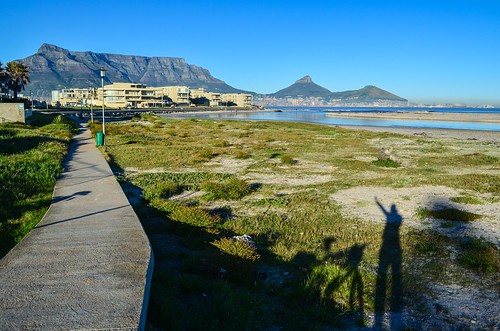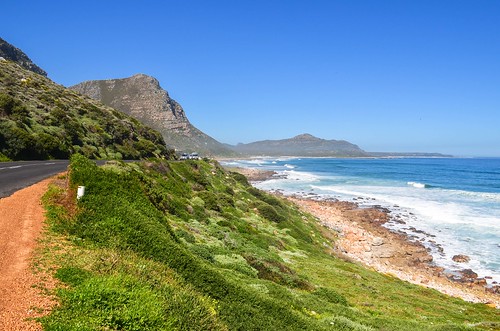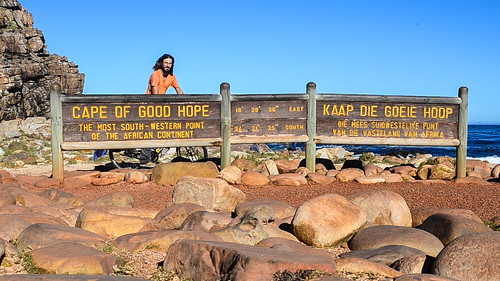Il tempo era nuvoloso quando sono arrivato a Città del Capo la settimana scorsa, ma oggi, l'ultimo giorno di agosto, sarà perfetto per la mia ultima tappa del giro in bici per l'Africa. Voglio terminare al Capo di Buona Speranza e, involontariamente, questo coincide con il GIORNO 666 e il KM 26500.

Il Capo di buona speranza si trova a circa 50 km a sud di Città del Capo. Partendo dai sobborghi settentrionali, dovendo attraversare tutta la città e percorrendo la strada occidentale, più lunga, mi porterà a circa 100 km. La Buona Speranza non è il punto più a sud dell’Africa e non è il luogo in cui l’Oceano Atlantico si incontra con l’Oceano Indiano. Quel punto è in realtà Cape Agulhas, 150 km south east of Good Hope, at 34°50′0.35″S instead of 34°21′29″S, and lies 50 km further south.
But I didn’t start from the northernmost point of Africa, so I don’t have to end at the southernmost one. And Good Hope is much prettier than Agulhas. It’s also historically more significant: reached by the first sailors in 1488 (still the Portuguese), it hosted the first large scale emigration of French Huguenots in 1687.

Non so se la gente consideri Città del Capo una città africana, dato che non assomiglia affatto alle altre grandi città del continente. Somiglia piuttosto a una città costiera europea, a meno che uno non si perda nei Cape Flats. Una differenza importante per me è la presenza di piste ciclabili, che in Africa sono rare quanto una Peugeot 504 in Svizzera. Con le piste ciclabili la domenica mattina, Città del Capo, una città di quasi 4 milioni di abitanti, sembra un villaggio.



However, in Woodstock, I start to have problems. The cycling lanes have disappeared so I left the highway where the difference of speed with cars is too much, and I am now stuck between two railways, between the Northern line and the Southern line, between Esplanade station and Woodstock station. It’s immediately less friendly, and the only man of the deserted streets to whom I ask my way suggests that I follow the railway tracks: it will lead me to the city center.
Sure it will, but after a few meters, it appears obvious that I won’t be able to push my bike on one or two kilometers of track ballast. It’s maybe the shortest way for pedestrians, but too long for me. U-turn then.

La mia altra opzione è allora il cavalcavia sopra la ferrovia, che implica portare la mia bicicletta su e giù per le scale, un esercizio che distrugge le spalle, anche con solo metà dei pannieri. Ma all'altro capo del cavalcavia, in fondo, a due metri dalla strada, un tornello mi blocca il passaggio. Altra sfortuna! C'è una porta aperta, dove potrei passare facilmente, ma una guardia di sicurezza poco amichevole rifiuta di farmi passare. Non so perché, dato che potrei passare senza la bicicletta, e comincio a odiare Città del Capo.

Un'altra inversione a U e un altro sollevamento della bici poi... e ora, dal sovrappasso pedonale, intravedo di nuovo la pista ciclabile: ora corre lungo la corsia MyCiti, un nuovissimo sistema di autobus a transito rapido.
Vorrei aver pianificato questo attraversamento di Città del Capo su internet, perché non è affatto ovvio sapere dove iniziano e finiscono le piste ciclabili. Qualche centinaio di metri più avanti, la pista ciclabile si ferma di nuovo, proprio nel CBD. C'è una grande rotatoria con semafori al centro. Come se avessero costruito prima la rotatoria e si fossero resi conto solo dopo che non funzionerebbe senza mettere semafori per entrare ed uscire. Semafori e rotatorie insieme non hanno senso, ma a dire il vero, è più chiaro di quanto sia altre rotatorie Ho visto in Africa, che funzionano con le seguenti regole: 1- le auto possono entrare nella rotonda in qualsiasi momento, e 2- un'auto suona il clacson per interrompere il flusso ed uscire. Ne risulta un cerchio rumoroso a velocità zero che deve sembrare un buco nero artificiale che inghiotte il traffico da tutte le direzioni.
A proposito, metà delle rotonde del mondo si trova in Francia, e per altri curiosi fatti sulle rotonde con l'accento più francese di sempre, c'è questo slideshow dalla National Roundabout Conference.

Mirando a attraversare il CBD nel modo più veloce e semplice possibile, afferro il primo ciclista che vedo e lo seguo per un po', prima di continuare da solo con le sue indicazioni. Attraverso la strada Buitengracht, un'importante intersezione del CBD, ma anche un luogo con un'attrazione speciale che aggiunge al senso del traffico di Città del Capo: un ponte autostradale che porta al nulla.

Il Battigia autostrade sono ben conosciuti dai capetonians poiché sono lì dal 1977. Ci sono molte storie intorno ad esso.
One school of thought blames it all on an engineering error, convinced that the project was abandoned when it became apparent that the two spans of the highway bridge were not going to come together at an expected point. Others say it’s all because a shop owner whose establishment stands (or used to stand) in the way of the bridge refused to budge. According to a slightly different story, it was because the city authorities would not pay him pay him what he asked for. There are even some people who, tongue-in-cheek, maintain it was a plain and simple Hollywood conspiracy. According to them, the construction was never even intended to be sculpted into a bridge. Instead, it was meant to become the world’s top scenic spot for driving a car off a bridge in a movie. The official explanation is that the city had run out of the money and decided to stop the work on the projected highway. The traffic volumes at the time did not justify the cost anyway, and there were other priorities.
Dato che passo così vicino, faccio loro visita. C'è una bella vista e sarebbe un ottimo posto per una festa. Due senzatetto hanno costruito un rifugio in una delle corsie.



Finalmente ritrovo la pista ciclabile a Green Point, e da ora è facile uscire dalla città. Passo davanti allo Stadio di Città del Capo, costruito per la Coppa del Mondo di calcio del 2010, e che oggi è gestito congiuntamente dalla stessa compagnia francese che si occupa dello Stade de France.
Poi c'è Sea Point, dove molti europei hanno comprato delle case, e dove non sembra affatto l'Africa che conosco.



Così tante persone fanno jogging, camminano, vanno in bicicletta, pattinano a rotelle, ecc. Sembra una grande città, forse come Nizza, con tanti giovani. È un bel modo per concludere il viaggio transafricano, iniziando in Europa e finendo in un ambiente simile all'Europa.
Dopo aver passato i sobborghi molto eleganti di Clifton e Camps Bay, il luogo ideale per una casa vacanza di un ricco uomo d'affari, sono finalmente lontano dalla gente e dal traffico. La mia strada mi porta lungo i pittoreschi Dodici Apostoli, il lato atlantico ripido della Table Mountain.

I meet a lot runners and cyclists on this road. One of them stops and tells me that September 1st, tomorrow, is Spring Day, meaning that all outdoors activities can resume after a cold and rainy winter. There are many cyclists preparing for the Cape Argus, the world’s largest timed cycle race with over 35’000 contestants, on these very same roads, in March.
La città sulla mia strada è Llandudno, a surfing spot and expensive suburb, where a Zimbabwean minister built a Villa grandewhen he was supposed to have only Zim dollars.


I am not yet halfway to the Cape of Good Hope, but the landscape gets prettier and prettier.


There is that sign just after Hout Bay: “Cyclist stay alive at 1.5 m“. It sounds like it’s telling ciclisti to respect a distance when being overtaken by a car … it’s weird. The law in France states that a motorist overtaking a cyclist must leave a distance of 1 meter in urban centers, and 1.5 m in all other cases. So it’s great to see that the same applies in Cape Town. After all, Africa is still a continent where a man on a bicycle is a poor man who can’t afford a faster vehicle; cycling is not seen as a healthy and convenient transportation mode or a leisure activity. That’s why I have a flag hanging from my rear panniers on the traffic side, to increase the distance left by motorists from 10 cm to 30 cm.

There, the sign is placed in a way it can only address cyclists, when obviously, motorists are the ones to be taught how to respect slower vehicles, not the other way around. I’ve also seen a journalist on South African TV saying that “not all cyclists respect the 1.5 m rule” … How can a driver expect a cyclist, already riding as close to the gutter as he can, to distance himself from cars overtaking him? This whole mentality sounds very messed up.
On the other hand, that man in Hout Bay, giving me directions, who was also doing a lot of hiking and cycling, gave me another point of view. He said the Cape peninsula is a wonderful place for trail running, but runners should always go in a group to avoid opportunist bush criminals. He also said that cyclists around Cape Town are more or less at war with motorists: they don’t ride in a single file, but side-by-side, they don’t obey traffic rules, and they take ownership of the road. It’s not smart either.

Dopo Hout Bay, fino a Noordhoek, la strada si chiama Chapman’s Peak Drive, ed è una strada stupenda. C'è un pedaggio per i veicoli, ma i ciclisti passano gratuitamente. È una versione mediterranea della strada da film di James Bond, guidando tra le Alpi. Spesso è troppo stretta per fermarsi, anche per una bicicletta, ma sicuramente mi rende felice non aver scelto il lato est della penisola, passando per Muizenberg.




Poi mi passa Kommetjie, un altro spot per il surf, e la sua cento - anno-vecchio faro. La strada mi conduce dolcemente al parco nazionale del Capo di Buona Speranza.





Devo pagare la quota di ingresso di R105 per gli ultimi 10 chilometri, poiché fanno parte del Parco Nazionale del Table Mountain. Per un breve tratto, pedalo sulla stessa strada con uno struzzo.



Capo Point è un altro capo, molto vicino al Buon Consiglio. È il luogo del faro più potente del Sudafrica. Giro a destra e... è la fine!


In realtà non è così facile scattare una foto. Il parco nazionale attira turisti e bisogna mettersi in coda.

Questo è tutto per i miei 666 giorni e 26609 chilometri sulla strada. Ora, sono in vacanza!








Ho avuto la fortuna di pedalare in quest'area un paio di volte, che fantastico finale per un viaggio così straordinario!
Wow! Storia e foto fantastiche! Grazie mille per aver condiviso. Davvero un'impresa!!
Ho affidabili ragguagli sul fatto che per un po' di tempo non ci sarà molto 'prossimo passo'... 🙂 oltre a questo, è un risultato per tutta la vita e crescerà solo di valore. Congratulazioni, jb! Molto, molto orgoglioso
JB,
Mi sono imbattuto nel tuo blog quando parlavi delle arance in Spagna. Alla prima lettura non comprendevo cosa significasse pedalare attraverso l'Africa fino a Città del Capo.
Ora che seguo il tuo Blog, controllando regolarmente gli aggiornamenti del tuo viaggio, ho un'idea un po' più chiara di cosa potrebbe essere. Ma penso comunque che sia un po' difficile da credere.
Congratulazioni a te per il tuo coraggioso viaggio! Non vedo l'ora di vedere cosa succederà dopo.
Tutto il meglio
Martin
Sì, è cambiato molto dalla Spagna!
Grazie per le tue parole